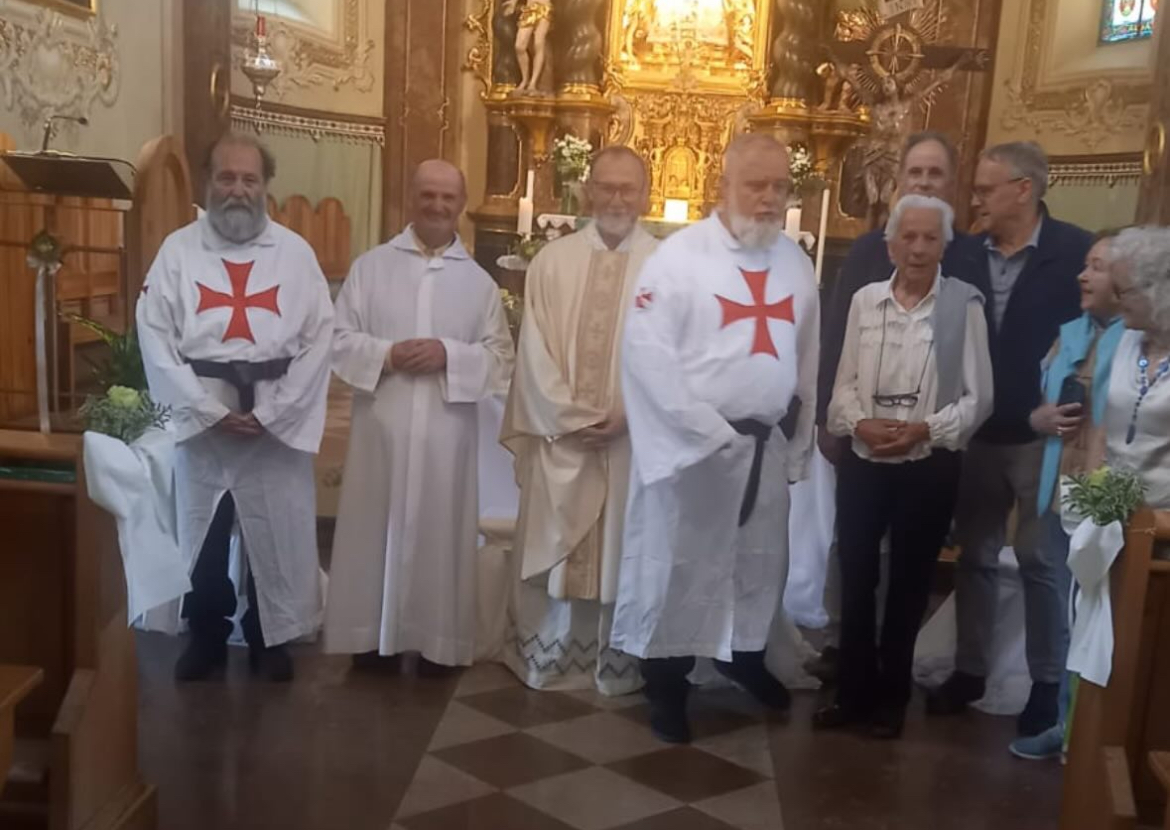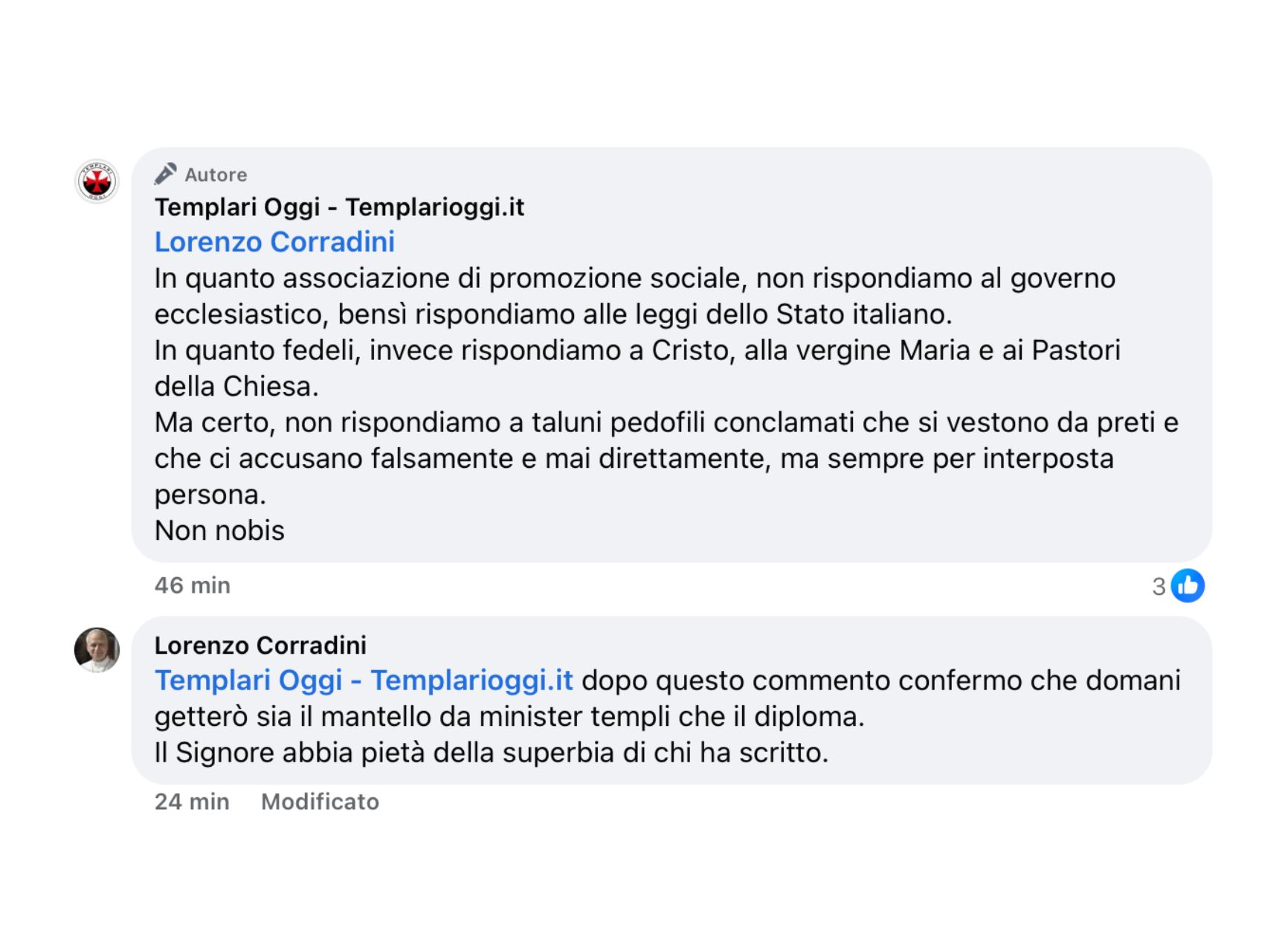Rome – In recent months, the Dicastery for the Laity, the Family and Life has found itself dealing with a reality that, despite repeated warnings and even canonical suppression, continues to operate undisturbed in parishes and public celebrations: this is the case of the so-called "Templari Oggi", a group that combines medieval symbols, anachronistic rituals, and a systematic use of the habit to gain space and recognition. And they do so with an attitude that has little to do with Christian humility, and much to do with vanity, the thirst for visibility, and, in some cases, verbal aggression toward the Church and its Pastors.
A reality already suppressed... but still present
In February 2022, the Bishop of Verona canonically suppressed the association "Templari Cattolici d’Italia" (now renamed "Templari Oggi", although the website still bears the old name), due to serious and repeated behaviors: acts of disobedience, refusal to dialogue with ecclesiastical authority, changes of location without authorization, and a general attitude of closedness and self-sufficiency. The CEI itself, in a confidential letter – made public by Silere non possum – in May 2025, warned Italian bishops, inviting them not to give space or collaborate with this group, deemed incompatible with the ordinary ecclesial path.
Yet, despite official warnings, Templari Oggi continue to be present in parishes, participate in liturgical celebrations with their flashy white cloaks marked by crosses, offer themselves as volunteers and behave as if they were an integral part of ecclesial life. Their presence is far from discreet: they march into sanctuaries, attend celebrations with bishops, station themselves in shrines, offer “security service”, but the true goal seems to be just one: to be seen, to show off the habit to feel important.
The Zuppi case: a wound to credibility
What made the issue even more serious and divisive was a recent event: on May 22, 2025, the Templari Oggi were present in Bologna during a solemn Mass presided over by Cardinal Matteo Zuppi, president of the CEI. A bewildering gesture, which scandalized many faithful and priests, especially since it occurred just days after the CEI’s letter forbidding their presence. No explanation was offered by the cardinal, who prefers to go laugh in the salons of La Repubblica while the newspapers speak ill of Leo XIV. However, his silence was louder than any word.
Silere non possum continues to receive numerous reports of events where members of the so-called "Templari Oggi"participate publicly, despite the explicit ban of the Dicastery for the Laity, the Family and Life. These individuals seem to ignore – or pretend to ignore – a basic principle: an association, even if recognized civilly by the Italian State, when operating within the Catholic Church, is subject to the dispositions of ecclesiastical authority. Therefore, it is necessary to start a serious reflection on all the agreements the Italian State has signed with the "Templari Cattolici d’Italia", as a group previously recognized by the Church. These agreements – particularly regarding the management of some religious sites, the opening and closing of churches, and their surveillance – must be reviewed in light of the canonical suppression. In fact, when an association is disavowed and suppressed by ecclesiastical authority, any collaboration based on that recognition automatically loses its validity, especially in areas involving direct interaction between Church and State. The Italian State, in compliance with current legislation and concordat agreements, cannot continue to legitimize entities not recognized by the Church, much less when they operate in open opposition to Church directives.
As we know, however, some cardinals, bishops, and presbyters act solely out of “friendship” or “convenience”, and therefore have no interest in the decisions of the Holy See which has prohibited their involvement in celebrations. After all, it is a basic principle: these people are laymen and may take part in liturgy exactly as laypeople must: sitting in the assembly and dressed like everyone else. Many have asked: how can the same Church that bans them allow them to stand beside the president of the CEI?It is a gesture that undermines the credibility of the hierarchy, confuses the faithful, and above all creates space for systematic disobedience as a strategy of ecclesial survival.
Unconcerned with ecclesiastical directives
This morning in Cortina d'Ampezzo (Diocese of Belluno-Feltre) in the Church of the Blessed Virgin of the Defense, they participated in Holy Mass, as they do on a regular basis. In Como, Cardinal Oscar Cantoni welcomed them in the Cathedral during priestly ordinations. Many other reports are arriving from all parts of Italy.

Criminally relevant behavior
Following the revelations made by Silere non possum—for which many prelates and laypeople have thanked us, precisely because someone had deliberately worked to keep everything hidden and confidential, thus allowing everyone to continue doing whatever they wanted—the Templari Oggi Association deemed it appropriate to send us a threatening letter in which they claim to have even reported us to the authorities. Attacks on journalists in Italy are becoming increasingly frequent, and are often even endorsed by certain branches of power. For this reason, Silere non possum has long initiated several procedures to ensure that such intimidation is met with an appropriate response at the international level.
What is important to reiterate here is that Silere non possum will not be intimidated by these cowardly attempts at pressure, which are entirely unfounded and without any legal basis. We will continue to publish the truth, as always, in accordance with the facts and official documents. In reality, Silere non possum has merely made public official acts: if there is something to object to, it should be the content of those documents, not their publication. The canonical proceedings—including rulings from Roman authorities—are clear: the members of this association have systematically violated ecclesiastical norms, and it is precisely for this reason that the association has been canonically suppressed. The frantic reactions and public ramblings published by these individuals do not change the reality of the facts and deserve no credibility. In fact, many of the serious statements they themselves have published—for instance, on their Facebook page—confirm exactly what several bishops have reported. Just consider the case of the Diocese of Ascoli Piceno, where Monsignor Gianpiero Palmieri has repeatedly expressed his concern over the presence and intrusive behavior of these individuals.
All of this makes a thorough investigation and a serious review of what is happening even more urgent. Because the problem lies not only in what they do, but in what they claim to be—disregarding the truth, the discipline of the Church, and the respect due to ecclesiastical authority.
What makes all of this even more unacceptable are the public statements made by the Templars themselves, who responded to the Church’s warnings in gravely offensive tones. In one of their most violent outbursts, they wrote:

A sentence that encapsulates all the arrogance and contempt with which these self-proclaimed knights approach the clergy. Not only do they claim the right to take part in public functions while disregarding official directives, but they also presume to lecture the Church itself, making grave, vague, and slanderous accusations—as if they could pose as judges of a world they seek to exploit rather than to serve.
Behind the cloak, the void
In many ecclesial circles, the mechanism has now become clear: these “Templars” have no real interest in ecclesial service or in a life of faith shared with the community. Their main concern is to be the center of attention, to use the habit as an identity mask, and to insert themselves into religious settings in order to gain personal gratification and social recognition that they would not find elsewhere. In the end, a cloak and a red cross are all it takes to feel invested with a mission—even if that mission is merely the reflection of a desire for self-importance.
Yet the real problem is not just them. The real question is: why are they still being welcomed in churches? Why don’t parish priests, rectors, and even some bishops put an end to this farce? The ambiguity and silence of pastors risk legitimizing these distortions. One cannot condemn something in theory and then, in practice, throw the doors wide open. Today, consistency is the only credible form of witness.
The Templars Today are the symbol of a broader issue: the distorted use of the Church for personal ambitions, the illusion that a garment alone bestows authority, the attempt to hide pride behind the appearance of service. The Church has the duty to unmask all of this—with clarity, with courage, and above all with coherence. Failing to do so means betraying its own mission.
d.C.V.
Silere non possum